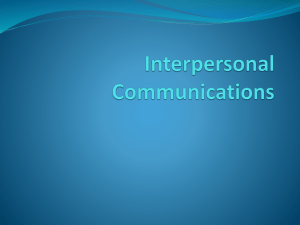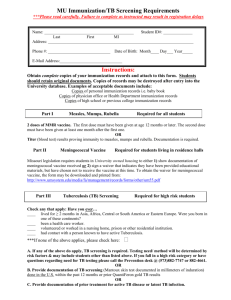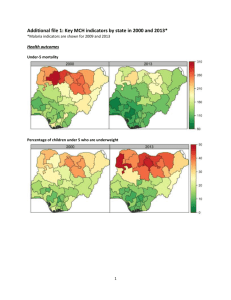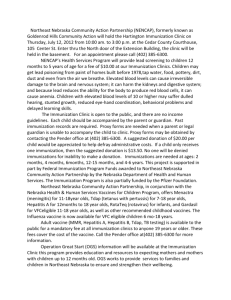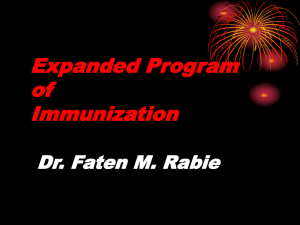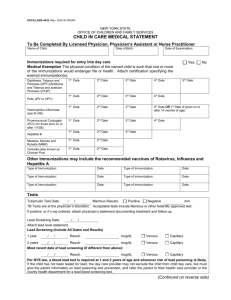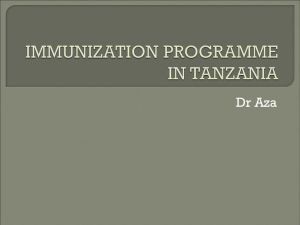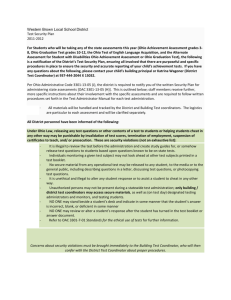Statewide Immunization Registry
advertisement
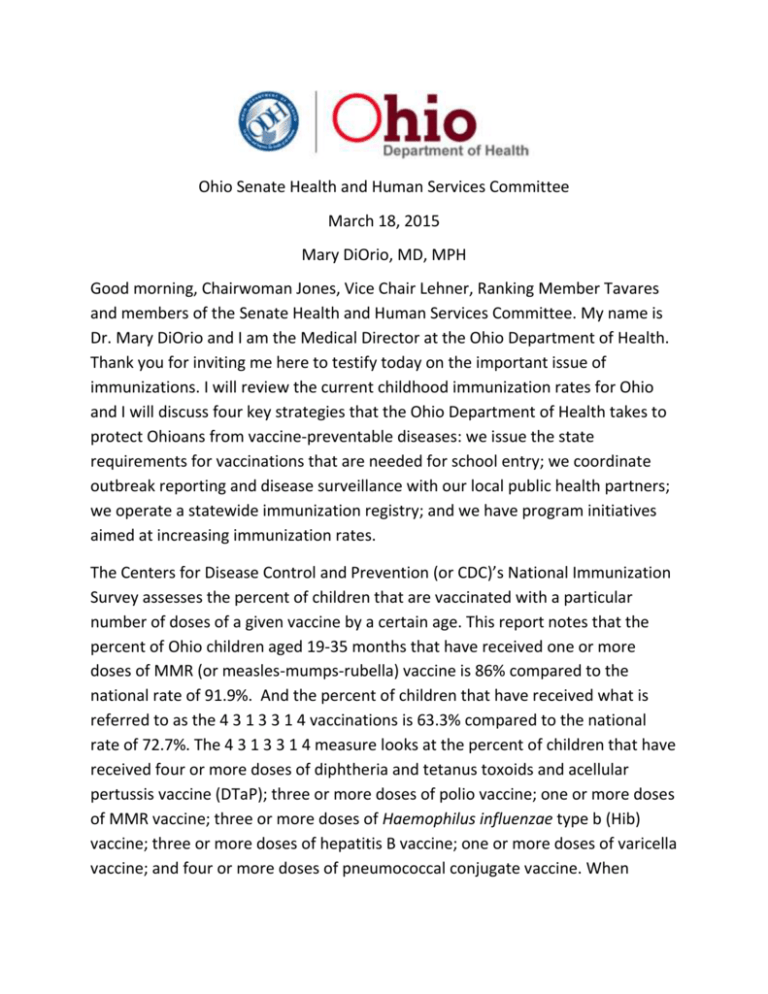
Ohio Senate Health and Human Services Committee March 18, 2015 Mary DiOrio, MD, MPH Good morning, Chairwoman Jones, Vice Chair Lehner, Ranking Member Tavares and members of the Senate Health and Human Services Committee. My name is Dr. Mary DiOrio and I am the Medical Director at the Ohio Department of Health. Thank you for inviting me here to testify today on the important issue of immunizations. I will review the current childhood immunization rates for Ohio and I will discuss four key strategies that the Ohio Department of Health takes to protect Ohioans from vaccine-preventable diseases: we issue the state requirements for vaccinations that are needed for school entry; we coordinate outbreak reporting and disease surveillance with our local public health partners; we operate a statewide immunization registry; and we have program initiatives aimed at increasing immunization rates. The Centers for Disease Control and Prevention (or CDC)’s National Immunization Survey assesses the percent of children that are vaccinated with a particular number of doses of a given vaccine by a certain age. This report notes that the percent of Ohio children aged 19-35 months that have received one or more doses of MMR (or measles-mumps-rubella) vaccine is 86% compared to the national rate of 91.9%. And the percent of children that have received what is referred to as the 4 3 1 3 3 1 4 vaccinations is 63.3% compared to the national rate of 72.7%. The 4 3 1 3 3 1 4 measure looks at the percent of children that have received four or more doses of diphtheria and tetanus toxoids and acellular pertussis vaccine (DTaP); three or more doses of polio vaccine; one or more doses of MMR vaccine; three or more doses of Haemophilus influenzae type b (Hib) vaccine; three or more doses of hepatitis B vaccine; one or more doses of varicella vaccine; and four or more doses of pneumococcal conjugate vaccine. When reviewing a statistical evaluation like this National Immunization Survey, one needs to consider the “confidence interval” for each item being assessed. A “confidence interval” is a statistical measure that gives the range of values within which one is confident to a certain degree that the true value is located. For Ohio’s MMR vaccination rate of 86%, the 95% confidence interval is plus/minus 5.2% and for Ohio’s 4 3 1 3 3 1 4, the 95% confidence interval is 7.6%. Thus, the true value may be higher or lower than that which is reported. Because of confidence intervals, it can also be somewhat challenging to compare states directly, as overlapping confidence intervals can make these direct comparisons difficult. However, what is important to note from this survey, is that there is room for improvement, especially within this young age group. When we compare the immunization rates of the National Immunization Survey with our Ohio AFIX rates and the rates that are noted at kindergarten entry, there is an increase with each of these measurements. For example the MMR rate as noted in the National Immunization Survey is 86% for children aged 19 to 35 months, in the Ohio AFIX survey this increases to 88.9% and by school entry, the rate is 96.1%. This illustrates the importance of immunization requirements for school and how these requirements help get children up-to-date with their immunizations. As Ohio had been the only state without a childcare vaccination requirement, until recent passage of House Bill 394, immunization rates of childcare aged individuals (the exact ages that the National Immunization Survey is assessing) have not had the benefit of a boost in immunizations due to a requirement. That should change with the new law. Administer State Requirements In regards to immunization requirements for school entry, Ohio law (O.R.C. 3701.13 and 3313.671) requires that at the time of initial entry or at the beginning of each school year, elementary and high school students are to have documentation of immunization against several vaccine-preventable diseases. These diseases include chicken pox, measles, mumps, rubella, polio, diphtheria, pertussis, tetanus, and hepatitis B. Students may have exemptions for immunizations under several scenarios, including medical contraindications or for if the parent or guardian declines an immunization due to “reasons of conscience, including religious convictions.” Ohio Revised Code section 3313.67 requires that all schools report a summary of the immunization status of their pupils to the Ohio Department of Health by October 15 of each year. Accordingly, ODH surveys all schools in Ohio for the immunization summaries of preschool, kindergarten, seventh grade and new pupils in grades 1-12. ODH currently uses an online reporting process for all schools in Ohio. Immunization rates are public health quality indicators for local health departments. Thus, local health departments partner with school districts to increase vaccination rates through collaboration, education, outreach, and reporting efforts. This past December, Governor Kasich signed House Bill 394 which strengthened vaccination requirements in child care settings. The law requires that children attending state licensed child care facilities be vaccinated according to the Centers for Disease Control and Prevention’s Advisory Committee on Immunization Practices’ (ACIP) schedule. A parent must provide the child care provider with a medical statement within 30 days of enrollment noting that the child has been vaccinated or is in the process of being vaccinated. Similar to the elementary and high school requirements, this law allows for exemptions for medical reasons and reasons of conscience or religious conviction. ODH has been working in collaboration with the Ohio Department of Job and Family Services and other stakeholders to implement this new requirement. Coordinate Outbreak Reporting and Surveillance As you have read or heard in the media, in the past year Ohio has had several significant regional vaccine-preventable disease outbreaks related to measles and mumps. Ohio has also had many local outbreaks of diseases like pertussis and influenza. These local outbreaks are not as visible, but they are much more common than the larger regional outbreaks. The state’s communicable disease surveillance and investigation process to respond to these outbreaks is wellcoordinated and efficient. Public health is able to monitor certain diseases, like the vaccine-preventable diseases that we are discussing, because they are required to be reported to public health. Individual cases (and outbreaks) are reported by clinicians, hospitals and laboratories. Local health departments investigate each case within their jurisdiction and enter pertinent information about each case into the state’s electronic disease reporting system which is known as the Ohio Disease Reporting System. The Ohio Department of Health provides technical assistance to local health departments as needed, aids with coordination of multi-jurisdiction investigations and secures laboratory testing and/or additional vaccine for outbreak control if appropriate. Communications between local health departments and ODH often occur on a daily basis, especially when outbreaks are on-going. As I mentioned, Ohio experienced two significant regional outbreaks of mumps and measles last year. The 2014 mumps outbreak involved a total of 482 cases that occurred between January 1 and September 20, 2014. To assist with containing the outbreak, ODH provided 1,346 mumps-containing vaccine doses to local health jurisdictions in central Ohio. The 2014 measles outbreak involved a total of 382 cases that occurred between April 21 and July 21, 2014. These cases occurred in a highly unvaccinated population of the state, with Knox County having the most cases. In response to this outbreak, the Ohio Department of Health provided local health departments with approximately 11,000 doses of vaccine. Local health departments administered the vaccine at their clinics and at approximately 120 independent vaccination clinics that they established increase their outreach and ensure additional access to vaccine. In addition to these large regional outbreaks, in 2014, there were also 44 outbreaks of pertussis and 2 outbreaks of varicella (or chickenpox) reported. These outbreaks occurred predominantly in schools settings. In addition, during the current 2014-2015 influenza season, there have been 75 suspected or confirmed influenza outbreaks reported. These outbreaks have been mostly in healthcare settings, specifically nursing homes and assisted living facilities. This flu season has been a challenging one with a significant increase in the number of hospitalizations reported compared to the previous two seasons. This is due in large part to a vaccine that was a poor match to the predominantly circulating strain of influenza virus. As a result, To date, there have been 7,985 hospitalizations this influenza season compared to 4,223 and 2,667 during similar time periods within the 2012-13 and 2013-2014 influenza seasons respectively. And there have been 6 influenza-associated pediatric deaths this season compared to zero during the 2013-14 season. In response to the flu epidemic this season, the Ohio Department of Health laboratory has tested over 1,100 influenza specimens from outpatient centers and hospitals across the state to determine which influenza viruses are circulating. Statewide Immunization Registry Another key strategy that the Ohio Department of Health utilizes to address vaccine-preventable diseases is the maintenance and promotion of a statewide immunization registry. The Ohio Department of Health uses an interactive system for recording and tracking immunizations called ImpactSIIS or Statewide Immunization Information System. As of January 1, 2015, ImpactSIIS held more than 72 million immunization records on more than 8.5 million individuals. In 2014, more than 2500 separate locations around Ohio contributed immunization data to ImpactSIIS. These included local health departments, Federally Qualified Health Centers, hospitals, physician’s offices, pharmacies, schools, and payers. ImpactSIIS was developed to help achieve complete and timely immunization for all Ohioans, but especially for the age group most at risk - birth through two years. It does this: By maintaining consolidated, comprehensive immunization records By making immunization records accessible to those with an appropriate health care or public health need while preserving the security of individual information By identifying when an individual is due for a vaccination and notifying the patient and/or the provider about this And by managing vaccine inventory for immunization providers As a central data processing point, ImpactSIIS provides an accurate, efficient way to ensure that children and Ohioans of all ages receive the right vaccinations at the right times without unnecessary repetition. A recently passed legislation, House Bill 394 required ODH to prepare a report detailing the feasibility of requiring all individuals who administer vaccines in Ohio to submit vaccine administration information to ImpactSIIS. ODH is in the process of completing that report, and we look forward to working on ways to increase public health knowledge of vaccination rates around the state in order to better target our interventions. Administer Program Initiatives Finally, I would like to take this opportunity to briefly outline for the committee the work of the ODH Immunization Program, including program initiatives that are aimed at increasing immunization rates in Ohio. The Immunization Program provides education and support to immunization providers to improve immunization coverage. The program’s goal is to reduce and eliminate vaccinepreventable diseases among Ohio's children, adolescents and adults by working with health care providers and public health partners to improve immunization rates and to prevent the spread of vaccine-preventable diseases. The Ohio Department of Health seeks to prevent 17 vaccine-preventable diseases: diphtheria, tetanus and pertussis; Haemophilus influenzae type b (Hib); hepatitis A; hepatitis B; human papillomavirus (HPV); influenza; measles, mumps and rubella; meningococcal disease; pneumococcal disease; polio; rotavirus; varicella (chicken pox) and zoster (shingles). To achieve this, ODH administers grants, distributes vaccine, and provides technical assistance and training. In addition, the ODH Immunization Program administers the federal Vaccines for Children Program or VFC. The VFC program provides vaccines at no cost to children who might not otherwise be vaccinated because of an inability to pay. Ohio estimates that 50.5% of Ohio children are eligible for VFC vaccine. Ohio has approximately 1,100 VFC providers including private providers, local health departments, Federally Qualified Health Centers and Rural Health Centers. VFC providers administer VFC-provided vaccine to the eligible children from birth through age 18 years of age. Eligible children are those on Medicaid, American Indians/Alaskan Natives, and un- and under-insured children. Immunization Billing Before I close, I would like to mention language in the proposed budget that addresses immunizations. There is an increased number of Ohioans who have coverage through Medicaid or private health insurance for immunizations. Local health departments and other providers can bill private insurers to recoup the cost of providing vaccinations. Thus, the Fiscal Years 2016-17 biennial budget proposes discontinuing the use of General Revenue Funds beginning January 1, 2016, to purchase vaccines for distribution to local health departments and other providers to vaccinate individuals who are now eligible for vaccinations through private health insurance. ODH will continue to provide funding to local health departments and other providers for vaccines for the first half of 2016 to give them sufficient time to develop their billing capabilities and build up their vaccine inventory. In addition, the federal VFC (Vaccines for Children) Program for will not be affected by this proposal. In closing, preventing and controlling the spread of infectious diseases, particularly vaccine-preventable diseases, is a core priority and a pillar of public health. The dramatic decrease in vaccine-preventable diseases that occurred in the twentieth century is a public health success story. To refocus on core public health activities, ODH has recently realigned its structure. ODH’s new organizational structure aligns the agency to promote collaboration, operate more effectively and efficiently, and better plan for and manage the changing health care landscape. As I have mentioned, we work very closely with local health departments, health care providers, and other state and local partners to achieve our public health goals. Our immunization partners are numerous and include pediatricians, family physicians, internists, obstetricians and gynecologists, nurse practitioners, school nurses, public health nurses and pharmacists. All contribute to Ohio’s commitment to improve vaccination rates across the lifespan. Thank you again for this opportunity and I would be happy to answer any questions you may have.

